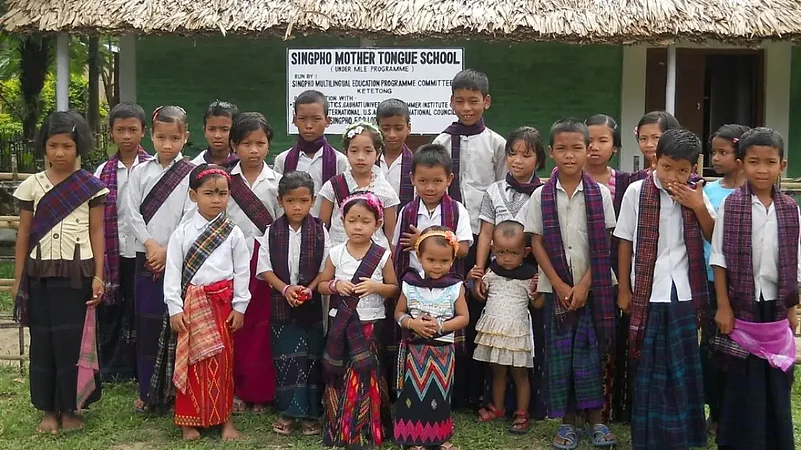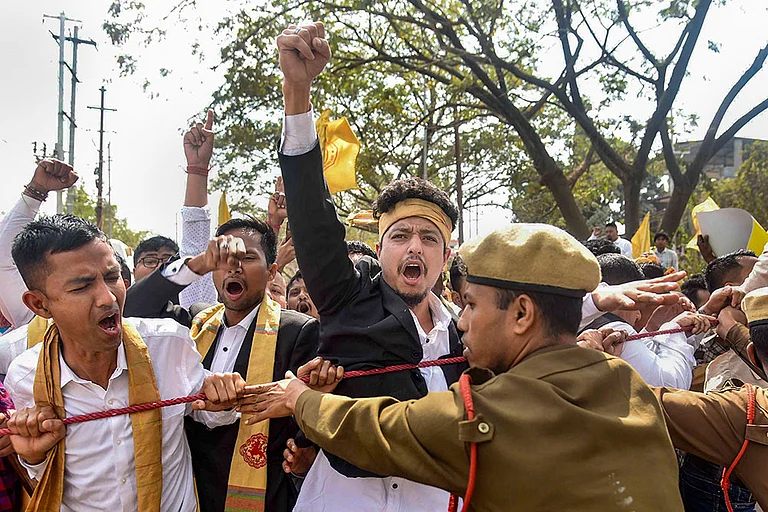The Ahoms, the longest-ruling community of Assam, originated in Yunnan in Southwest China. In the 13th century, the Ahom people crossed the Patkai range in the Indo-Myanmar border and settled in the vast Brahmaputra valley. The Ahom dynasty that ruled Assam for 600 long years, from 1228 to 1826 till the signing of the treaty Yandaboo is considered to be a glorious chapter in the history of Assam. However, the Ahom language that belonged to the Tai language family in which Assam’s glorious past is recorded in the form of “Buranjis” (chronicles of the Ahom kingdoms) is now a nearly extinct language.
“When a language dies, stories, songs, traditions, and knowledge die along with it. When you keep a language alive, you keep the identity, culture and tradition of a group of people alive”, says Palash Kumar Nath, a researcher and a linguist from Assam’s North Guwahati.
Nath, an Assistant Professor of Anundoram Borooah Institute of Art and Culture, has been actively working on digital documentation and revival of some of the indigenous languages belonging to the Tai language family - Tai- Khamyang and Tai Phake as spoken in Northeast India. He has been also working toward the revival of Singpho language which belongs to the Tibeto-Burman language family.
While Tai-Phake is spoken by a few thousand people in some of the villages situated in the Dibrugarh and Tinsukia districts, the Tai-Khumyang language is spoken by a handful of people who reside in Powaimukh village of the adjoining Tinsukia district of Assam.
These people are sub-groups of Mongoloid Tai racial stock of Southeast Asia who came to the state and settled in the Brahmaputra valley during the ancient and medieval period.
While there were six branches of the greater Tai language in Assam, two languages- Tai-Ahom and Tai-Turung are already extinct while Tai Phake and Tai-Khamyang are critically endangered.
In 2006, Nath worked with an international team of researchers on a research project with the Singpho, Tangsa and Turung and Tai Phake communities to document their languages. In 2014, he took up the work of documenting the Tai Khamyang language.
“If a language is not transmitted from older to younger generation, its death is imminent. In the case of the Tai-Khumyang community, the language is spoken by a few people between the age of 70-80. That means the language will take only 20-25 years to become extinct if it doesn’t get passed on to the next generation. So there was an urgency to revive the language because along with its death, the traditional knowledge and ecological knowledge of the community will be lost forever.”
Organising week-long workshops, Nath started working closely with the community members and started documenting the oral and written materials related to their history, tradition, folk stories, songs, manuscripts, rituals etc. With the help of the community members, he produced storybooks for children in the Singpho and the Tai-Khamyang language to help them learn the language.
In 2009, using the materials collected from the community, Nath and his team of community members started Singpho Mother Tongue School in Ketetong village of Tinsukia district.
“We helped the community to start giving education to around 25 children from the age of three after their regular school. We would provide them storybooks written in Singpho script, teach the script and give ecological knowledge etc.”
The school was the result of a complete community-supported effort that was later partially funded by a development council meant for eight communities. However, due to the lack of funding, the school eventually closed.
Assam, with a population of 3.1 crores, is home to around 80 indigenous groups (tribes and sub-tribes). According to the People's Linguistic Survey of India, Assam has approximately 55 languages.
Apart from the languages of the Tai community, 15-20 languages in Assam are endangered says Dr Arup Kumar Nath, Assistant Professor at the Department of Linguistics and Language Technology of Tezpur University. Dr Nath says, the reasons why languages are dying fast in this part of the region are mainly because of negative attitudes towards one’s mother tongue, less number of speakers, diminishing usefulness of the language and the spread of Christianity in the culturally and linguistically diverse reason.
Around 80 other languages are facing the threat of extinction in Northeast India, a region that has over 200 languages belonging to no fewer than five language families of Indo-Aryan, Tibeto-Burman, Austro-Asiatic, Tai-Kadai and Dravidian language groups.
“Christianization has been happening in the Northeast at a very fast pace. As a result, the pace of westernization in this region is also visible, especially among the tribal and indigenous communities adopting English language," Nath said. "Secondly, till very recently the tribal communities were also looked down upon by the Caste Hindus, which is why, the missionaries could mobilize and attract them to their way of thinking, living, and preaching. This was also projected as the road to modernization."
The role of the English language has been immense in the invisibalisation and even extinction of local north-eastern languages. English was represented as the language of opportunities, aspiration, and prestige. As a result, many speakers of native languages shifted to English or other dominant languages. Nath added that the lack of proper preservation and promotion policies and planning on the part of the government has led to the loss of these languages.
The Centre for Endangered Languages of the Department, in Tezpur University, is one of the three such centres in Northeast India, set up by the University Grant Commission. It is currently working on seven endangered languages of three North-eastern states. These are Biate from Manipur, Hrangkhol and Khelma from Assam, Onaemela and Liangmai from Manipur and Purum and Yimchunger from Nagaland.
The centre is trying to revitalize and document these languages by motivating and encouraging the native speakers of these languages, building reading capacities through publishing learners' books like texts on Morphology, Syntax, Phonology, Ethno-linguistics, etc. In absence of written scripts of these languages, the centre has used Roman script.
“We are trying to reduce the negative attitude toward their languages from the minds of the native speakers and instil a sense of pride for being the speakers of these beautiful languages. We are also trying to produce at least a few community linguists who can continuously work for their languages.” Nath said.
Neighbouring Arunachal Pradesh, the largest state of Northeast India with a population of 12.6 lakhs is also the least densely populated state of India situated in its easternmost corner. With 26 tribes and 100 or more sub-tribes, 33 languages of the state are listed as endangered by UNESCO. The local speech community members are trying to preserve these languages through digitalisation of oral histories, documenting traditional knowledge, rituals, beliefs and myths. In some cases, communities are also trying to prepare scripts for these languages.
Banwang Losu, a school teacher from Longding district of Arunachal Pradesh that shares its boundary with Myanmar has developed a script of the Wancho- a Tibeto-Burman language, spoken by the Wancho tribe scattered in Arunachal Pradesh, Assam, Nagaland and in Myanmar.
Losu have been working for more than two decades to preserve the language, culture and traditions of the community.
“At first I wanted to document the socio-economic and cultural aspects of the tribe. But later I found that using the Roman or Devanagari script, documenting is not possible. It is because of the tones and sounds. So I started to work on developing a script for the language in 2001.”
Now the Wancho script is also available in Unicode. It has 29 consonants and 15 vowels. The government of Arunachal has also introduced the languages in Primary and Upper Primary schools.
The text books are comprised of folk songs, stories, environmental education among others. According to Losu, 39, the efforts of the Arunachal tribes grew out of the very painstakingly slow government planning processes to revive the dying language.
In another district of Changlang, Wanglung Mossang, a farmer has developed a script for the Tangsa language. The Tangsa tribe comprising around one lakh members speaks Tangsa, a Sino-Tibetan language which did not have a script till a year ago. In 1990, Lakhum Mossang, a man from the community started to develop a common script for the Tangsa language which has at least 40 dialects. However, after his death in 2020, the script remained incomplete.
From there Wanglung Mossang took over the work and completed the script within a year. Mossang also conducts classes to teach the Tangsa language to school and college students. In 2021, the Arunachal government included the language in its Primary school curriculum.
Lisa Lomdak, a Linguist of the Centre for Endangered Languages, Rajiv Gandhi University of Arunachal Pradesh, in her paper writes, “Tribal languages of Arunachal Pradesh show serious signs of endangerment mainly caused due to negligence and faulty provisions of the Governance which have not facilitated the mother tongues of the tribal to be functional and useful outside the home domain. In the state, the political and cultural groupings and re-groupings have also accentuated the inequality that already existed within. The most affected ones have been the young speakers and smaller/minor speech communities.”
The Centre has been working to revive critically endangered languages (as per UNESCO Atlas) like Tangam spoken by the Tangam sub-tribe of the Adi, located in a pocket of Upper Siang district. As per the Centre, Tangam has only 253 reported speakers.
Linguists have framed a basic grammatical sketch and made a repository of 1000 Tangam words and around 550 basic sentences. The Centre has also collected audio-visual data on the language and culture of the Adi community people. The institution is also working towards reviving the Kasik and Khamba language by documenting the basic words, sentences and rituals associated with it.
Sikkim, the last state to be incorporated in the Northeast region, shares three international boundaries- Tibet in the North and Northeast, Bhutan in the East, and Nepal in the West. There are at least 34 languages in the state which are considered endangered. Dr Samar Sinha, a linguist and Coordinator of the Centre for Endangered Languages at Sikkim University says the number of endangered languages in Sikkim might be higher in the sense that many remote community languages are yet to be discovered.
Currently the centre has started documenting five endangered languages of Sikkim and North-Bengal which share a single linguistic ecology. These are Magar, Gurung, Sherpa, Bhujel and Rokdung. Sikkim has got 13 official languages of which 12 are endangered, except the Nepali Language.
Talking to Outlook, Dr Sinha said, “The five languages are chosen because they are critically endangered and require immediate attention. The older speakers are also not able to pass it to the young speakers. Young people are more interested to learn the dominant language of the state. We have not provided anything for the languages to grow. The main challenge is that in the case of some languages there is no native speakers. Like in case of the language of Bhujel, a language from Nepal, that has been adopted and practised by communities here."

Reena Rai, a resource person of the centre and a native speaker of the Kulung language is working on developing a grammar base for the language. The Kukung people are a sub-tribe of the Rai community in Sikkim which has at least eight distinct languages. Around 500 people from the sub-tribe of Kulung speak the language. They are populated in three different districts of Sikkim. Kulung is indigenous to Nepal and parts of North-eastern Sikkim.
“The Kulung People uses the Devanagari script for writing the language. I am attempting to develop the grammar for the Kulung language so that we can have a script of our own," Rai told Outlook.
According to Bishnulal Bhujel, a PhD student from the Bhujel community of Sikkim, there is only one native speaker left in his community in Sikkim. He has recently developed a script, and a dictionary for the Bhujel, another critically endangered language of the state. The Bhujels earlier used to use the Devanagari script. Now it uses Kharpa, a script developed in the 1980s by CB Bhujel which got popularised recently. It has 29 consonants, 6 vowels and 5 diacritics and numerics.
In 2018, Bishnulal Bhujel developed a phonetics script of Kharpa along with his team of researchers at the Centre for Endangered Languages. According to Akhil Sikkim Bhujel Sangha, as of 2021, there were 6063 people from the Bhujel community residing in four districts of Sikkim. This year the Sikkim government has listed the language as one of the State Indigenous Languages. It has been included in the school curricula from the current academic session.
"Languages spoken by an indigenous community are dying rapidly and there are multiple reasons for that. But what is alarming here is the rate at which languages are dying without evolving into another language. It’s a natural phenomenon that one language evolves into a different language, sometimes two languages come together and form another language. But such things are not happening really. What is happening is that one dominant language is over taking the weaker and smaller languages”, Dr Samar Sinha laments.


























